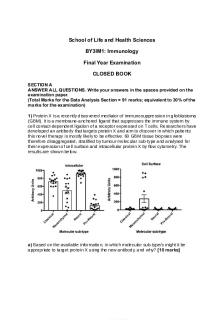Immunology Practice Exam PDF

| Title | Immunology Practice Exam |
|---|---|
| Course | Immunology |
| Institution | Aston University |
| Pages | 7 |
| File Size | 416.5 KB |
| File Type | |
| Total Downloads | 84 |
| Total Views | 128 |
Summary
Immunology Practice Exam...
Description
School of Life and Health Sciences BY3IM1: Immunology Final Year Examination CLOSED BOOK SECTION A ANSWER ALL QUESTIONS. Write your answers in the spaces provided on the examination paper. (Total Marks for the Data Analysis Section = 91 marks; equivalent to 30% of the marks for the examination) 1) Protein X is a recently discovered mediator of immunosuppression in glioblastoma (GBM). It is a membrane-anchored ligand that suppresses the immune system by cell contact-dependent ligation of a receptor expressed on T cells. Researchers have developed an antibody that targets protein X and aim to discover in which patients this novel therapy is mostly likely to be effective. 60 GBM tissue biopsies were therefore disaggregated, stratified by tumour molecular sub-type and analysed for their expression of cell surface and intracellular protein X by flow cytometry. The results are shown below.
a) Based on the available information, in which molecular sub-type/s might it be appropriate to target protein X using the new antibody, and why? [10 marks]
b) The researchers run statistical analyses on their data sets and find that there are significant differences between sub-types for intracellular, but not cell surface, protein X expression levels. Does this change your answer to part A? Explain your answer. [10 marks]
2. Protein Y is a recently discovered tumour antigen in Glioblastoma (GBM). To learn more about the expression of protein Y, researchers take a variety of cell populations from three GBM patients and three healthy controls and assess protein Y mRNA levels in these cells. The results are shown in the heat map below.
a) To which category of tumour antigen can protein Y be assigned? Explain your answer. [10 marks]
b) Why is this type of antigen particularly immunogenic? [10 marks]
3. The figure below shows a schematic representation of a protein antigen (shown four times) within the plasma membrane of a cell. Each circle represents an amino acid within the protein structure. In each example, the amino acid residues that contribute to the epitope of four different mAbs (mAb 1- mAb 4) are shown in black.
a) List those mAbs that are most likely to be effective mAbs for the detection of the antigen by flow cytometric staining of intact live cells. [2 marks]
b) Briefly justify your reasoning with reference to the mAb epitope composition shown. [10 marks]
c) List those mAbs that are most likely to be effective mAbs for the detection of the antigen in western blotting following SDS-polyacrylamide gel electrophoresis. [3 marks]
d) Briefly justify your reasoning with reference to the mAb epitope composition shown. [10 marks]
4. A mAb (93F2) is known to bind to macrophages and prevent the binding of yeast
particles to the phagocyte. Further study was undertaken to identify the antigen to which this mAb 93F2 binds. HEK cells were mock-transfected (HEK/mock) or transfected with CD654 (HEK/CD654) and after successful expression were then incubated with either a fluorescent control mAb or fluorescent mAb93F2. The viable intact cells were analysed by flow cytometry and the results are shown below.
a) Appraise these data with reference to the detection and identity of the antigen recognised by mAb 93F2. [10 marks]
b) Outline one additional experimental approach that may definitively identify the antigen to which mAb 93F2 binds. [10 marks]
5. Human leukocytes were isolated and stained using immune-fluorescence microscopy. The results are shown below. Identify one possible cell type for each of the cell populations shown (two on each dot plot). You should write directly on the figures. [6 marks]
END OF SECTION A
SECTION B ANSWER ONE ESSAY QUESTION.
1. Appraise the involvement of cell adhesion in a successful, protective immune response to an invading pathogen, and the avoidance of disease. 2. Compare and contrast the contribution of macrophages in the prevention and promotion of disease. Illustrate your answer using specific examples. 3. Discuss the challenges of tumour microenvironment and immunoediting for chimeric antigen receptor T cell therapies in glioblastoma.
END OF PAPER...
Similar Free PDFs

Immunology Practice Exam
- 7 Pages

Immunology
- 36 Pages

Transplant Immunology
- 2 Pages

immunology quiz
- 9 Pages

RA immunology
- 2 Pages

Immunology Terminology
- 2 Pages

CHIA Practice Practice Exam
- 22 Pages

Immunology ILA
- 22 Pages

Immunology worksheet
- 6 Pages
![Immunology MCQs [5618]](https://pdfedu.com/img/crop/172x258/qk2qoz18m4rw.jpg)
Immunology MCQs [5618]
- 31 Pages
Popular Institutions
- Tinajero National High School - Annex
- Politeknik Caltex Riau
- Yokohama City University
- SGT University
- University of Al-Qadisiyah
- Divine Word College of Vigan
- Techniek College Rotterdam
- Universidade de Santiago
- Universiti Teknologi MARA Cawangan Johor Kampus Pasir Gudang
- Poltekkes Kemenkes Yogyakarta
- Baguio City National High School
- Colegio san marcos
- preparatoria uno
- Centro de Bachillerato Tecnológico Industrial y de Servicios No. 107
- Dalian Maritime University
- Quang Trung Secondary School
- Colegio Tecnológico en Informática
- Corporación Regional de Educación Superior
- Grupo CEDVA
- Dar Al Uloom University
- Centro de Estudios Preuniversitarios de la Universidad Nacional de Ingeniería
- 上智大学
- Aakash International School, Nuna Majara
- San Felipe Neri Catholic School
- Kang Chiao International School - New Taipei City
- Misamis Occidental National High School
- Institución Educativa Escuela Normal Juan Ladrilleros
- Kolehiyo ng Pantukan
- Batanes State College
- Instituto Continental
- Sekolah Menengah Kejuruan Kesehatan Kaltara (Tarakan)
- Colegio de La Inmaculada Concepcion - Cebu





